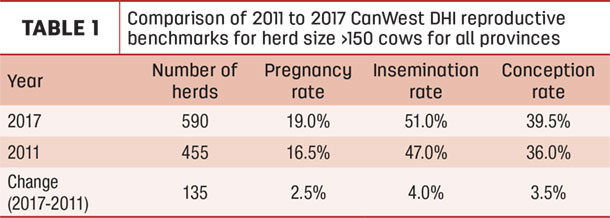As well, sexed semen has now become a widely accepted product, giving herds the ability to create more female pregnancies and subsequent female calves, which opens new opportunities for genetic strategies.
CanWest DHI started to annually publish reproductive performance data by herd size in 2011. For analysis reasons, the focus is on herds greater than 150 cows. Using herd size above 150 cows helps to give a large enough cow population to limit the variability in pregnancy, insemination and conceptions that can be seen in herds smaller than 150 cows. In herds with more than 150 cows, lactating cow reproductive performance improved in 2017 compared with 2011 (Table 1).

Technology at work
The increase in reproductive performance should not be a surprise given the significant investment in technology, tools and genetics that have entered the industry over this period. Activity monitoring technologies and timed-A.I. protocols have evolved during this time. Activity monitoring technologies now rely on the radio transmission of data to the farm computer, allowing data to be analyzed in “real time.” Activity monitoring technologies have also added features such as rumination time, standing and lying time, feeding time, and panting time. All these parameters help for more high accuracy in heat detection and timing of breeding. A survey conducted by the University of Guelph in 2014 on reproductive management showed almost 25% of freestall or bedded-pack dairy farms surveyed bred over 50% of their cows at first service from an activity monitoring system.
The University of Guelph survey also showed that 81% of herds used timed A.I. at some point in their reproductive protocol. Timed-A.I. protocols, such as Double Ovsynch, have helped improve first-service conception rates over this period. As well, improved use of Resynch protocols and the implementation of ultrasound in the last decade have helped to identify open cows and get them rebred in a timely manner.
Genetics play a part in repro improvements
Genetic factors must also be considered as a reason for the improvement in reproductive performance over this period. Since the introduction of genomic evaluations, the industry has seen improvements in genetic gains in low-heritability traits such as Daughter Fertility. In the period before genomics became available (2004-09), Daughter Fertility in Holsteins was dropping at rate of -0.72 according to the Canadian Dairy Network (CDN). Since genomics were introduced, Daughter Fertility is now moving in a positive direction, showing a 1.06 gain over a five-year period (2011-16). Improvements in Daughter Fertility genetics is likely a factor in why reproductive performance has improved since 2011.
Heifer management matters
One of the shifts in herd management over the past decade has been the increased focus on heifer management. The greatest impact of this change can be seen on the age at first calving. The age at first calving has been reduced by more than a month over the last seven years, according to DHI data from herds above 150 cows that are recording heifer data in accordance with DHI guidelines (Table 2). While the age at first calving has come down, the percentage of heifers pregnant at first breeding has also declined. The reduction of 2.5% in first-service pregnancy may be the result of more aggressive insemination strategies, which can lead to a reduction in conception because more marginal animals are being bred. As well, the significant increase in the use of sexed semen likely has had a slight impact on overall conception rates.

How are herds performing?
Even though reproductive performance numbers have improved, how many herds are achieving above-average performance for both insemination and conception rate? Using CanWest DHI reproductive level data from 2017 in herds above 150 cows, we classified herds into four categories of reproductive performance (see Figure 1). For the purpose of this analysis, insemination and conception rate goals were set at 50% and 40%, respectively. The insemination rate goal was set at 50% because the DHI data assumes the voluntary waiting period is 50 days in milk. Because not all herds start at 50 days, some herds’ insemination rate data will be lower than the actual rate on farm. If over 50% of available cows are being inseminated over a cycle, the breeding program is being managed to a higher degree. A conception rate of 40% was chosen, as it is an achievable goal for dairy herds to target and slightly above the 2017 average.

Sixteen percent of the herds achieved both insemination and conception rates above the cut points (greater than or equal to 50% and greater than or equal to 40%, respectively), whereas 29% of herds had both insemination and conception rates below the cut points. Being above both cut points means a pregnancy rate greater than or equal to 20%, whereas being below both cut points means a pregnancy rate less than 20%. As shown in Figure 1, 27% of herds had a conception rate greater than or equal to 40% while having an insemination rate less than 50%. The remaining 28% of herds had conception rates less than 40% and insemination rates greater than or equal to 50%. Overall, 84% of herds need to focus on at least one of the major reproductive metrics.
Although reproduction performance has improved over the last decade, it is still a major economic opportunity for dairy farms. With dairy herds continuing to invest in new technologies, such as activity monitoring and female genomic testing, it will be exciting to see what reproductive performance numbers we can achieve 10 years from now. ![]()

-
Mark Carson
- Genetic Solutions Manager
- Semex









